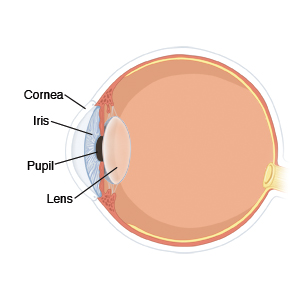Your contact lens can cause injury to the cornea. The cornea is the protective covering for the front of the eye and helps focus light on the retina. This injury can occur if you sleep with a hard or soft contact lens in place or r if you wear a contact lens longer than advised. There is a greater risk of injury if your eyes dry out too much while wearing a contact lens.
The cornea is very painful when injured, but it usually heals quickly. It usually improves within 24 to 48 hours. Your healthcare provider may apply an eye patch. This is to reduce pain and speed up the healing process. Antibiotic ointment or eye drops may also be used. Healing is complete when the pain stops and there are no other symptoms, such as eye redness, tearing or discharge, or blurred vision.
Home care
-
Don't wear contacts until you are pain-free.
-
A cold pack may be put over the eye for 20 minutes at a time to reduce pain. To make a cold pack, put ice cubes in a plastic bag that seals at the top. Wrap the bag in a clean, thin towel or cloth.
-
Acetaminophen or ibuprofen can be used for pain, unless another medicine was prescribed. If you have chronic liver or kidney disease, talk with your healthcare provider before using these medicines. Also talk with your provider if you have ever had a stomach ulcer or gastrointestinal bleeding.
If an eye patch was applied:
-
Put the cold pack directly over the eye patch as described above.
-
If you were given a follow-up appointment for patch removal and re-exam, don’t miss it. An eye patch should not be left in place for more than 48 hours, unless you are advised to do so by your healthcare provider.
-
Don’t drive a motor vehicle or operate machinery with the patch in place. You will have trouble judging distances with only one eye.
Follow-up care
Follow up with your healthcare provider, or as advised.
When to seek medical advice
Call your healthcare provider right away if any of these occur:
-
Eye pain gets worse or does not get better after 24 hours
-
Discharge from the eye
-
Redness of the eye or swelling of the eyelids gets worse
-
Vision gets worse


